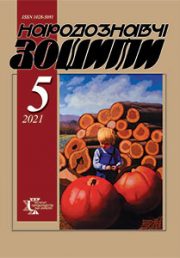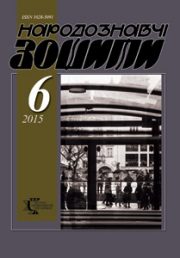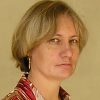The Ethnology Notebooks. 2025. № 4 (184), 825—830
UDK902.2:069.4/.5(477.83/.86)”185/195″
DOI https://doi.org/10.15407/nz2025.04.825
KUTSENYAK Oksana
- ORCID ID: https://orcid.org/0009-0002-5057-3467
- Head,Lviv Historical Museum,
- Department «Museum of the History of Ukraine»,
- 6, Rynok Square, 79008, Lviv, Ukraine,
- Contacts: e-mail: okutsenyak@gmail.com
FУLУPCHUK Halyna
- ORCID ID: https://orcid.org/0000-0002-2768-6706
- Candidate of Historical Sciences, Senior Researcher,
- Institute of Ethnology of the National Academy of Sciences of Ukraine,
- Department of Historical Ethnology,
- 15, Svobody Avenue, 79000, Lviv, Ukraine,
- Contacts: e-mail: galsoloviy@ukr.net
Abstract. The article introduces for the first time information on the history of receipt, museum attribution and description of artifacts from the «Archaeology» fund collection of the Lviv Historical Museum, which were once associated with the family of the famous cultural, public and political figure, Count Volodymyr Didushytskyi and with the activities of the Didushytskyi Natural History Museum. The study is especially relevant today, not only in view of the anniversary date (200th anniversary of the birth of V. Didushytskyi), but also precisely in times of war, when the issue of one’s own history, roots, cultural heritage and identity stands on a par with a clear awareness of one’s own separate vector of development on the path of civilized and democratic progress of humanity. Volodymyr Didushytskyi and his family actively participated in the development and institutionalization of museum work in Galicia in general and in Lviv in particular in the second half of the 19th century — the first half of the 20th century. Archaeology was one of the passions of the Didushytsky family. The main purpose of the article is to familiarize the scientific community with the archaeological heritage of the Volodymyr Didushytsky family, which is now partly stored in the funds of the Lviv Historical Museum. The chronological framework of the study covers the second half of the 19th century — the first half of the 20th century, namely the time when the archaeological collections entered the Didushytsky Museum of Natural History and their receipt in 1940 in the funds of the Lviv State Historical Museum (now the Lviv Historical Museum) as a result of the reorganization of Lviv museums under Soviet rule. The object of scientific research is the archaeological collections of the Volodymyr Didushytsky family, and the subject is archival and museum documentation, which is a source for accounting, collection, systematization, identification and scientific attribution of these museum items.
Thanks to the application of various general scientific and special methods of historical science (comparative-historical, typological, systemic, etc.), the history of the arrival of archaeological objects related to the family of Volodymyr Didushytskyi into the fund collections of the Lviv Historical Museum has been clarified.
Keywords: museum, archaeological object, collection, archaeology, artifact, archaeological culture, cultural institution, archaeological research, historical and cultural heritage, Didushytsky family.
Received 25.07.2025
REFERENCES
- Zarubii, E., Krashanovych, O., & Kutseniak, O. (2020). Archaeology at the Lviv Historical Museum. Lviv; Drohobych: Kolo [in Ukrainian].
- Brzеk, G. (1994). The Dzieduszycki Museum in Lviv and its Founder. Lublin: Lublin Publishing House Nowe [in Polish].
- Karolczak, K. (2001). The Dzieduszycki Family: History of the Poturzycko-Zarzecka Line. Krakow: Scientific Publishing House of the Pedagogical Academy [in Polish].
- Abramowicz, A. (1974). Far and near: sketches from the history of archaeology. Acta Archaeologica Lodziensia, 23, 131 [in Polish].
- The archaeological heritage of the Didushytskyi Museum. Joint seminar by Natalia Bulyk and Mykola Bandrivsky. Faculty of Humanities, Ukrainian Catholic University. Retrieved from: https://www.youtube.com/watch?v=xbZaIoL21w4 (Last accessed Мау 15, 2025).
- Bandrivskyi, M., & Krushelnytska, L. (2012). The Golden Treasures of Mykhalkiv and Their Fate. Lviv: Liga-Pres [in Ukrainian].
- Chornovol, I. (2004). From archaeology to suicide. Karol Gadacek. Lviv newspaper, 54 (378), 7 [in Ukrainian].
- Bulyk, N. (2014). Archaeology in Lviv in the 19th and early 20th centuries: researchers, scientific institutions, museums. Lviv: In-t ukrainoznavstva im. I. Krypiakevycha NAN Ukrainy; Іn-t ekonomiky i turyzmu [in Ukrainian].
- Bulyk, N. (2013). Karol Gadachek and his contribution to the development of Lviv archaeology (on the 140th anniversary of his birth). Materials and research on the archaeology of the Carpathian region and Volhynia (Issue 17, pp. 278—294) [in Ukrainian].
- Bulyk, N., & Berest, R. (2023). The Didushytsky familys mission in conservation and research of galician historical and archaeological heritage. Eastern European Historical Bulletin, 27, 81—89.
- Liekh, Y. (2006). From the history of Polish-Ukrainian relations in archaeology (late 18th century—1939). Archaeological research by Lviv University (Issue 9, pp. 17—53) [in Ukrainian].
- Przybyslawski, W. (1900) Two golden treasures in Michalkow. Conservation portfolio (Vol. II, pp. 31—43). Lviv [in Polish].
- Karachko, S. Mykhalkiv treasures. Heritage. Retrieved from: https://spadok.org.ua/starozhytnosti/mykhalkivski-skarby (Last accessed Мау 25, 2025) [in Ukrainian].
- Shukhevych, V. (1892). The Didushytsky Museum. Business. (Part 75) [in Ukrainian].
- Wiczkowski, J. (1907). Lviv, its development and cultural status, and a guide to the city. Lviv [in Polish].
- Inventory book of the «Archaeology» collection group. LIM Archive (Archive of Lviv Historical Museum) (Vol. 2: 1980—1981) [in Ukrainian].
- Inventory book of the «Archaeology» collection group. LIM Archive (Archive of Lviv Historical Museum) (Vol. 3: 1981) [in Ukrainian].
- Inventory book of the «Archaeology» collection group. LIM Archive (Archive of Lviv Historical Museum) (Vol. 4: 1981—1981) [in Ukrainian].
- Inventory book of the «Archaeology» collection group. LIM Archive (Archive of Lviv Historical Museum) (Vol. 9: 1983—1985) [in Ukrainian].
- Hrushevskyi, M. (1905). Materials on the history of socio-political and economic relations in Western Ukraine. Series One (1361—1530) (Parts 1—43; parts 44—80). Notes of the Shevchenko Scientific Society (Year XIV, vol. LXIII, book I. V [in Ukrainian].
- Dembinski, B. (1909). Count Wojciech Dzieduszycki. Lviv [in Polish].
- (1999). Dzieduszycki Wojciech. Britannica. Polish edition (Vol. 10) [in Polish].






